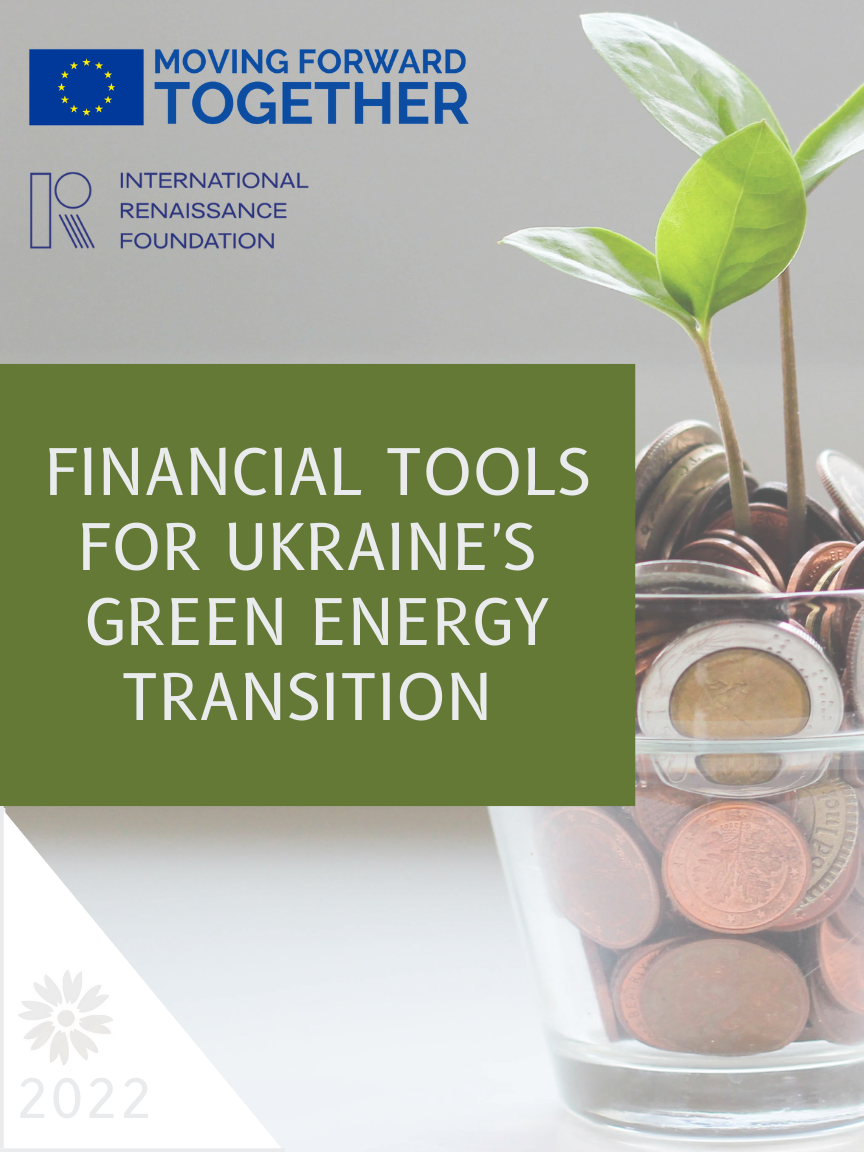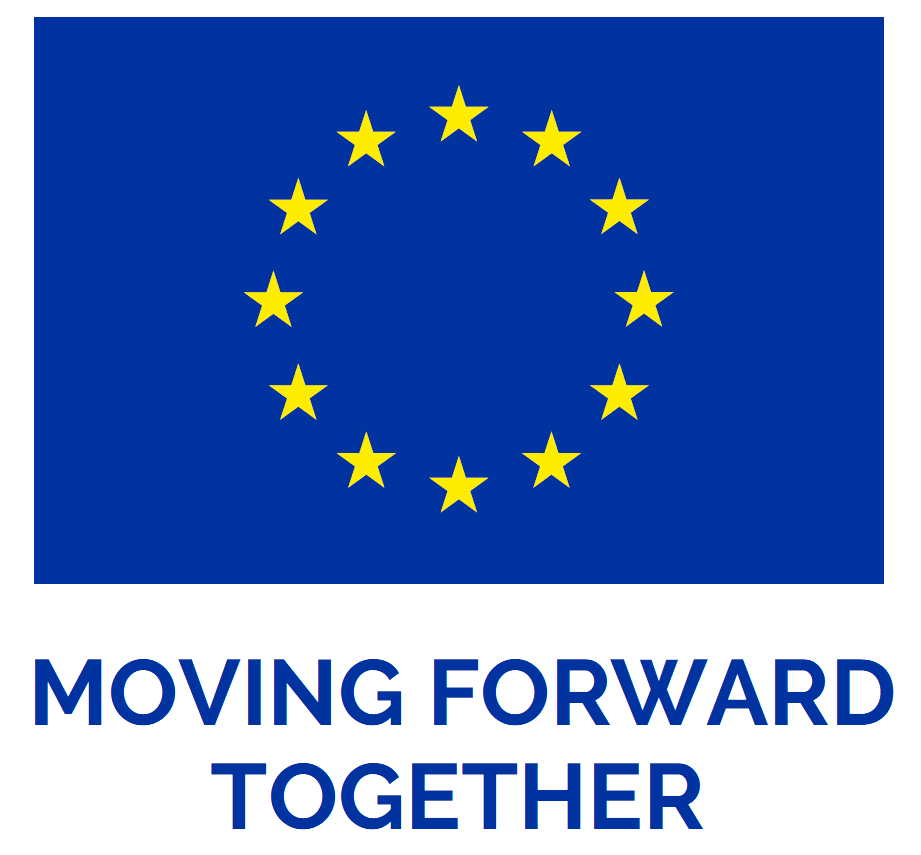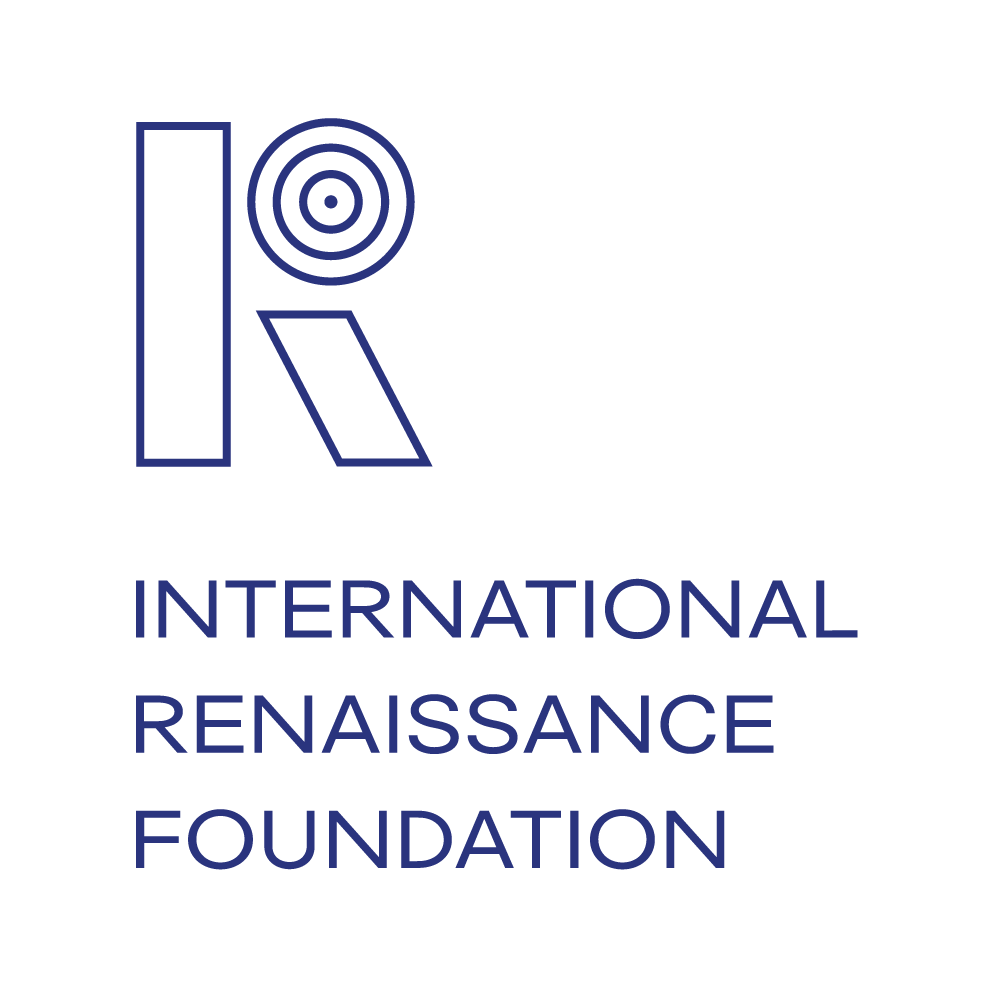FINANCIAL TOOLS FOR UKRAINE'S ENERGY TRANSITION
Supported by the International Renaissance Foundation and the European Union under the “EU4USociety” Project, the report conducted by the Ukrainian Sustainable Fund provides a comprehensive overview of the available and potential tools for financing the post-war recovery of Ukraine.

INTRODUCTION
The need for financing and decarbonizing Ukraine’s energy industry is just as urgent as it is undervalued. Since 2014, the country has managed to attract over EUR 8 billion in green investments and multiplied RES capacities almost ten times. Having adopted the sustainable approach, Ukraine also scaled its cooperation with the EU by ratifying the Paris Agreements and entering the EU4Climate Programme, helping the governments implement effective climate-related policies. The goals of achieving a 42% CO2 reduction compared to 1990 by 2030, while covering 50% of the country’s electricity needs with nuclear power, 25% — with renewable sources, and 13% — with hydropower have been set, and the transition has begun.
However, despite the rapid growth of renewable capacities (between 2014 and 2020, Ukraine has opened 9,223 MW of additional RES projects), the decarbonization process requires more attention. While the Ukrainian government proudly announces overachieving the 11% RES share in the energy mix (in 2020, it has reached 12.4%), Ukraine still falls behind on its CO2 reduction targets. According to the Climate Action Tracker analytics, the country’s current sustainability policy framework is “insufficient” and the 2030 goals are too unambitious for the Paris Agreement’s targets. Meanwhile, even the existing Nationally Determined Contributions (NDC), which include climate-neutrality by 2060, are hard to achieve given the lack of organizational and financial mechanisms in place.
Moreover, the COVID-19 pandemic and the russian invasion of Ukraine have imposed serious economic challenges and caused the destruction of critical energy infrastructure. Now, the question of shifting towards renewable energy is vital as never before.
GREEN STOCKS
Green stocks are, perhaps, the most obvious solution when it comes to green finance accumulation. This mechanism essentially involves purchasing shares from companies that contribute to sustainable development directly (through implementing green projects) or indirectly (through adopting responsible practices within their systems).
GREEN BONDS
Green bonds are one of the most popular tools for generating green finance. Borrowers around the world issue securities to finance sustainable projects, while investors receive profits when the bonds mature. In 2021, the global issuance level reached over $520 billion, which was a 75% increase from 2020. The total cumulative market for green bonds is valued at over $1.8 trillion.
GREEN LOANS
Green loans are cheaper and smaller in volume alternative of green bonds. This is also an instrument to raise finance specifically for financing sustainable projects. Over the past four years, green loans have risen from $342m to over $78bn in volume of issuance, which is a nearly 200-fold increase.
GREEN CERTIFICATES
Green certificates are a relatively new tool for securing green finance. Also referred to as Renewable Energy Certificates, Renewable Obligation Certificates (ROC), or Guarantees of Origin, green certificates exist to confirm that electricity has been generated by a sustainable energy source.
GREEN BANKS
Green banks are another rapidly growing green finance mechanism. These are usually publicly owned, commercially operated entities that aim to accumulate and direct domestic funds into environmentally responsible investment projects. Today, green banks already exist in 36 countries that account for more than half of the global GDP and almost half of the world’s CO2 emissions.
CARBON TAX
Carbon tax is a price set by the government that polluting companies must pay for each ton of CO2 emissions. By applying a carbon tax, the state, on the one hand, encourages companies to switch to clean fuel by spending a minimum of money, and on the other hand, creates conditions under which companies must adapt technologically in order to reduce emissions and remain competitive on the market.
GREEN GRANTS
Green grants are another way to directly attract funds for sustainable development projects. This mechanism is the most attractive for the grantees because it does not involve the transfer of ownership (as in the case of stocks) or financial obligations (as in the case of a loan). Instead of direct dividends, the investor benefits from improving their own image as a facilitator of green initiatives.
GREEN FUNDS
Green funds include venture and mutual funds that help impact investments and diversify risks. As for the latter purpose, Green ETFs become increasingly popular worldwide. Over just six months in 2021, 16 green ETFs performed better than the S&P 500, growing at a rate between 11% and 29.3%, while the S&P 500 index rose by 10.8%.
GREEN AUCTIONS
Green auctions differ from conventional ones because the winners are the companies that are ready to implement the projects with the greatest capacity at the lowest price. Such a tool is beneficial for the state, as it allows companies to be compared in terms of efficiency, technologies, and proposed prices for electricity, and also allows investors to choose the most trustworthy suppliers in order to reduce risks.
GREEN EXCHANGE
Green exchange is a new type of platform for trading green, social, and sustainable securities. The first green exchange(LGX) was created by Luxembourg Stock Exchange in 2016 as a direct contribution to the global climate goals defined in the Paris Climate Agreement and the UN SDGs.
GREEN FINANCIAL CENTERS
Green financial centers are another module of financial infrastructure designed to mobilize private capital. Globally, regulatory and market efforts are increasingly channeling savings toward the much-needed constructive investments required to underpin sustainable development.
ECO-INDUSTRIAL PARKS
Eco-industrial parks aim to incorporate industries into society by creating shared eco opportunities, improved ecosystems, and responsible business practices. They also serve as an incentive for FDI, leading to industries’ prosperity and increased employment opportunities.
Green stocks are, perhaps, the most obvious solution when it comes to green finance accumulation. This mechanism essentially involves purchasing shares from companies that contribute to sustainable development directly (through implementing green projects) or indirectly (through adopting responsible practices within their systems).
The global renewable energy market is expected to grow at an annual rate of 8.4%. And green energy stocks will be one of the major benefactors of this impressive expansion. Companies that are ranked among the top individual green stock issuers are not only the ones actually producing green energy. Electromobility, biodiversity, energy efficiency, or climate tech are just a few areas that can bring investors high returns while also allowing them to contribute to the mitigation of climate change consequences.
Green bonds are one of the most popular tools for generating green finance. Borrowers around the world issue securities to finance sustainable projects, while investors receive profits when the bonds mature. In 2021, the global issuance level reached over $520 billion, which was a 75% increase from 2020. The total cumulative market for green bonds is valued at over $1.8 trillion.
European countries together currently hold leadership in the volume of their green bonds market (trading almost half of the global bonds), and the euro is the main issuance currency. The US is the major individual issuer with China holding the second position.
The key projects on which the proceeds from green bonds are spent are the ones related to sustainable energy and buildings; a substantial amount of funding is also directed toward transport efficiency projects.
Although Ukraine has not yet issued green bonds, it is considered one of the most lucrative mechanisms for investors to be utilized after the war: with the newly published Green Bonds Roadmap and updated legislation, the sector is becoming increasingly transparent and risk-free, while the expected FDI flows in the post-war recovery period suggest the higher and faster returns on the bonds.
Green banks are another rapidly growing green finance mechanism. These are usually publicly owned, commercially operated entities that aim to accumulate and direct domestic funds into environmentally responsible investment projects. Today, green banks already exist in 36 countries that account for more than half of the global GDP and almost half of the world’s CO2 emissions.
Green banks are actively developing in the US, having invested $7 billion in clean energy projects since 2011. The ratio of overall investment to initial green bank investment in the US equals 3.7 to 1. In August 2022, the Inflation Reduction Act of 2022 also outlined conditions for the creation of a national Green Bank.
Overall, for the same period, green banks around the world have channeled over $25 billion into sustainable energy projects and crowded in about twice as much from the private sector.
Funding sources for these institutions vary by country and include government appropriations, bond issuance, private capital, carbon tax revenues, emissions trading funds, renewable energy credits, crowdfunding, and philanthropy.
Investment advisors maintain that the creation of a green bank can be one of the tools for Ukraine’s post-war reconstruction. While this is the case, more and more countries decide to redesign existing institutions into green banks or add green programs within existing banks as a more cost- and time-effective solution.
Green loans are a cheaper and smaller in volume alternative of green bonds. This is also an instrument to raise finance specifically for financing sustainable projects. Over the past four years, green loans have risen from $342m to over $78bn in volume of issuance, which is a nearly 200-fold increase.
European borrowers are responsible for nearly half of the loans that were secured by Italy’s EnelSpA and Belgium’s Interbrew-Simba. In Ukraine, green loans are issued by Ukrgasbank and have been gaining momentum since 2015. Among the uses for green loans are improving households’ energy efficiency, replacing agricultural equipment, and installing domestic aternative power stations.
Green certificates are a relatively new tool for securing green finance. Also referred to as Renewable Energy Certificates, Renewable Obligation Certificates (ROC), or Guarantees of Origin, green certificates exist to confirm that electricity has been generated by a sustainable energy source.
Hourly time-stamped energy certificates enable consumers to understand where their energy is coming from and what their carbon emissions are at any given moment. Besides, the certificates provide an important tool for countries characterized by relatively low economic or political stability as they guarantee are issued for a fee and cover potential risks and regulatory changes. They are often paid to partner banks, allowing the latter to lend to green projects.
Carbon tax is a price set by the government that polluting companies must pay for each ton of CO2 emissions. By applying a carbon tax, the state, on the one hand, encourages companies to switch to clean fuel by spending a minimum of money, and on the other hand, creates conditions under which companies must adapt technologically in order to reduce emissions and remain competitive on the market.
Since the tax on CO2 emissions is not harmonized, each country independently decides on its implementation. For this reason, the tax which is currently implemented in Ukraine and is one of the lowest in Europe has proven to be ineffective because it is not high enough to incentivize firms to switch to more sustainable practices. The suggestion is to raise the current tax to EUR 4.3/tCO2 as in Europe and achieve the EU target of EUR 39/tCO2 by 2030.
Besides, the carbon price should be increased gradually and in a predictable manner to allow investors to make long-term decisions and hence increase their funding for new energy projects.
Eco-industrial parks aim to incorporate industries into society by creating shared eco opportunities, improved ecosystems, and responsible business practices. They also serve as an incentive for FDI, leading to industries’ prosperity and increased employment opportunities.
For instance, in Vietnam, the creation of eco-industrial parks attracted 50% of foreign investment, created 3 million new jobs, and made EIP generate 40% of the country’s GDP. The 2012-2018 pilot project in 7 countries has led to 20,939 t/yr solid waste reduction, 59,800 tCO2/yr greenhouse emission reduction, 1,262,218 m3/yr water savings, and 6,746,642 EUR/yr saved.
Green exchange is a new type of platform for trading green, social, and sustainable securities. The first green exchange(LGX) was created by Luxembourg Stock Exchange in 2016 as a direct contribution to the global climate goals defined in the Paris Climate Agreement and the UN SDGs.
Securities listed on LuxSE that comply with mandatory LGX transparency requirements, which are based on international sustainable finance standards, can be considered for display on LGX. So far, the LGX has an international footprint with 135 issuers from 32 countries, issuing securities in a total of 32 currencies. As of 31 August 2020, LGX displayed 796 green, social and sustainable securities totaling USD 356 billion.
Green financial centers are another module of financial infrastructure designed to mobilize private capital. Globally, regulatory and market efforts are increasingly channeling savings toward the much-needed constructive investments required to underpin sustainable development.
Several global financial centers, including Casablanca, Frankfurt, Hong Kong, London, Luxembourg, and Paris have launched green or sustainable finance initiatives, including the Finance for Tomorrow Initiative (Paris), and the Sustainable Development Capital Initiative (London). The critical role of financial centers is promoting sustainable finance. This is being done through the International Network of Financial Centres for Sustainability (FC4S) and the Network for Greening the Financial System (NGFS).
Green auctions differ from conventional ones because the winners are the companies that are ready to implement the projects with the greatest capacity at the lowest price. Such a tool is beneficial for the state, as it allows companies to be compared in terms of efficiency, technologies, and proposed prices for electricity, and also allows investors to choose the most trustworthy suppliers in order to reduce risks.
As one of the recent examples, in August, Romania has been cleared to hold a national auction to fund at least 100MW of green hydrogen production, which would allow the country to produce 10,000 tonnes of green H2 a year, around 5% of the country’s current hydrogen demand. For Ukraine, which considers green hydrogen trade as one of the means of recovering the energy sector and the economy, green auctions might become a reasonable step to make when building the hydrogen production scheme.
Green grants are another way to directly attract funds into sustainable development projects. This mechanism is the most attractive for the grantees because it does not involve the transfer of ownership (as in the case of stocks) or financial obligations (as in the case of a loan). Instead of direct dividends, the investor benefits from improving their own image as a facilitator of green initiatives.
One of the leading green grantmakers in the world is the Global Ecological Facility (GEF). Since its introduction, the GEF has provided more than $20.5 billion in grant aid and co-financing for more than 4,800 projects in 170 countries. GEF subsidiary funds are The Least Developed Countries Fund, The Special Climate Change Fund, and The Adaptation Fund. These funds provide grant and technical support to projects aimed at facilitating access to natural resources and electricity, as well as climate change mitigation and adaptation. The GEF is financed by 39 donor countries.
Green funds include venture and mutual funds that help impact investments and diversify risks. As for the latter purpose, Green ETFs become increasingly popular worldwide. Over just six months in 2021, 16 green ETFs performed better than the S&P 500, growing at a rate between 11% and 29.3%, while the S&P 500 index rose by 10.8%.
Bloomberg’s five-year rankings show sustainable investing is not just for dreamers or climate enthusiasts. It is a money-making opportunity that is gaining popularity. The most lucrative green ETFs to invest in today are energy-related. They include iShares Global Clean Energy ETF (ICLN), Invesco WilderHill Clean Energy ETF (PBW), ALPS Clean Energy ETF (ACES), and others.
PRACTICAL IMPLEMENTATION OF THE PROJECT
The success of Ukraine’s post-war recovery will largely depend on the future of the country’s energy sector. Green energy transition must become key in forming Ukraine’s new economy, and in order to finance all the decarbonization steps outlined in the new NDC and the 2035 Energy Strategy, the government must develop a whole new field in Ukraine — that of green (or sustainable) finance.
Sustainable investment is a trend that now spreads around the world and includes investments from different sources that are dedicated to reducing emissions and waste, as well as increasing countries’ energy efficiency. Since 2014, the volume of green FDI in Ukraine comprised 30% of the total invested EUR 8 billion. Currently, RES projects in Ukraine are supported by Acciona (Spain), Emergy (Norway), Scatec (Norway), Total Eren (France), GS Engineering & Construction Corp (South Korea), CNBM (China), Guris (Turkey), Nebras (Qatar) and other global companies, as well as by EBRD, EIB, IFC, Proparco, FMO, IFU, BSTDB, and DFC.
However, in 2021, the updated NDC suggested that achieving Ukraine’s sustainability goals will cost around EUR 102 billion in capital investment by 2030, and now, 8 months through the full-scale invasion, this figure is expected to rise dramatically. The only way to secure such amount of funding is to develop sufficient green finance mechanisms to offer reliable and lucrative opportunities for investors.
The report shows that at the moment, the only effective green mechanism in Ukraine is the green tariff that has helped attract USD 4.5 billion as investments into wind and solar power in 2019 alone. However, this tool is unsustainable in the long run, since the government lacks resources to finance constantly increasing amounts of renewable power and already faces debts of almost USD 2 billion for the electricity market. The mechanism that is particularly promising in Ukraine’s case is green bonds, and the government is working leaps and bounds to offer a transparent legal framework for trading securities. However, all of the listed mechanisms can be useful for Ukraine sooner or later, and if implemented properly, Ukraine can not only pour billions of dollars into the post-war budget, but also position itself as a subject of the global climate change mitigation process, hence using its contribution towards decarbonization as a leverage in geopolitical security negotiations.


This publication was produced with the support of the European Union and the International Renaissance Foundation within the framework of the EU4USociety project. Its contents are the sole responsibility of the authors and do not necessarily reflect the views of the European Union and the International Renaissance Foundation
